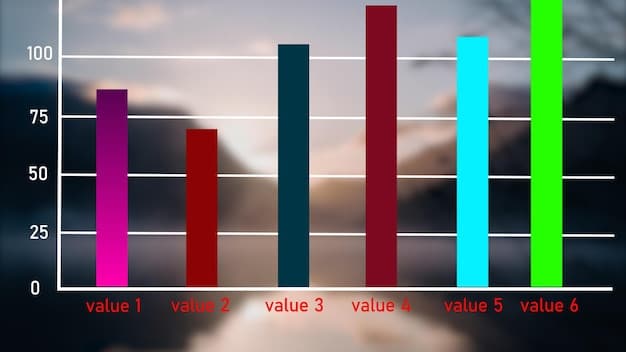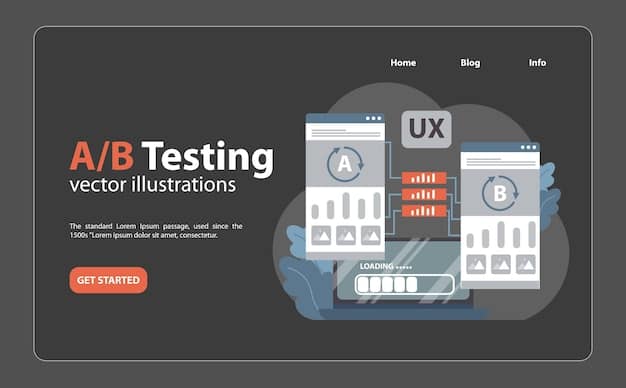How to Increase Conversion Rates with A/B Testing (2025 Update)

How to Increase Website Conversion Rates by 15% Using A/B Testing in 3 Months (2025 Update) involves a structured approach of hypothesizing, testing, and analyzing different website elements to determine which variations yield the best results, ultimately boosting conversions.
Are you looking to boost your website’s performance and turn more visitors into customers? In the ever-evolving digital landscape, staying ahead of the curve is crucial. This article provides a comprehensive guide on how to increase website conversion rates by 15% using A/B testing in 3 months (2025 update), offering practical strategies and insights for optimizing your website effectively.
By understanding the principles of A/B testing and implementing them strategically, you can unlock significant improvements in your conversion rates. Let’s delve into the world of A/B testing and discover how it can transform your online business.
Understanding the Fundamentals of A/B Testing
A/B testing, also known as split testing, is a method of comparing two versions of a webpage or app against each other to determine which one performs better. This is fundamental to how to increase website conversion rates by 15% using A/B testing in 3 months (2025 update). By showing these two versions (A and B) to similar visitors at the same time, you can identify which version leads to more conversions.
Key Components of A/B Testing
To effectively use A/B testing, understanding its key components is essential. Here are some fundamental aspects to consider:
- Hypothesis: A clear statement predicting which variation will perform better and why.
- Variables: Elements you will modify and test, such as headlines, images, or call-to-action buttons.
- Control (A): The original version of the webpage.
- Variation (B): The modified version you are testing against the control.
These components help structure your testing process and ensure that you are gathering meaningful data.
The Importance of a Clear Hypothesis
Having a well-defined hypothesis is crucial for successful A/B testing. It provides direction and focus to your testing efforts. A good hypothesis should be specific, measurable, achievable, relevant, and time-bound (SMART). For example, “Changing the headline on our landing page from ‘Learn More’ to ‘Free Trial’ will increase sign-up conversions by 10% within two weeks.”
In conclusion, understanding the fundamentals of A/B testing, including its key components and the importance of a clear hypothesis, sets the stage for a strategic approach to how to increase website conversion rates by 15% using A/B testing in 3 months (2025 update). By using these basics, you can conduct tests that will drive meaningful improvements on your website.
Setting Clear Goals and Metrics for A/B Testing
Before diving into testing, setting clear goals and identifying the metrics you’ll track is essential when thinking about how to increase website conversion rates by 15% using A/B testing in 3 months (2025 update). These goals should align with your overall business objectives and provide a benchmark for measuring success. Without clear goals, you’ll be testing without direction, impacting your returns.
Defining Your Conversion Goals
Conversion goals can vary widely depending on your business. Some common examples include:
- Increasing sales or revenue
- Boosting sign-ups or subscriptions
- Improving lead generation
- Reducing cart abandonment
Once you’ve decided on your conversion goals, define the metrics you’ll use to measure progress. These could include conversion rate, click-through rate (CTR), bounce rate, and average order value (AOV).

Selecting the Right Metrics to Track
Choosing the right metrics is crucial for accurately assessing the impact of your A/B tests. Here are some key metrics to consider:
- Conversion Rate: The percentage of visitors who complete a desired action.
- Click-Through Rate (CTR): The percentage of visitors who click on a specific link or button.
- Bounce Rate: The percentage of visitors who leave your website after viewing only one page.
- Average Order Value (AOV): The average amount spent per transaction.
Defining and tracking the appropriate metrics for your A/B testing efforts is essential in how to increase website conversion rates by 15% using A/B testing in 3 months (2025 update). It ensures you’re focused on the most impactful areas for improvement and can accurately measure your progress towards your goals.
Designing Effective A/B Tests
Designing effective A/B tests is critical to achieving meaningful results. This involves identifying elements to test, creating variations, and ensuring proper test setup. A well-designed test can provide valuable insights into how to increase website conversion rates by 15% using A/B testing in 3 months (2025 update).
Identifying Website Elements to Test
To start, identify specific elements on your website that could impact conversions. Common elements to test include:
- Headlines: Experiment with different wording and messaging.
- Call-to-Action (CTA) Buttons: Test varying button colors, sizes, and text.
- Images and Videos: Try different visuals to see which ones resonate best with your audience.
- Form Fields: Optimize the length and layout of your forms.
Focus on elements that have the potential to make a significant impact.
Creating Compelling Variations
Once you’ve identified the elements to test, create variations that are distinct from the control. Aim for meaningful changes that could drive noticeable improvements. To ensure your success in understanding how to increase website conversion rates by 15% using A/B testing in 3 months (2025 update), remember simplicity. Test one variable at a time for cleaner data.
Designing effective A/B tests requires careful planning and execution. By selecting the right elements to test and creating diverse variations, you can gather valuable data that will empower you to optimize your website for higher conversion rates.

Implementing and Monitoring A/B Tests
Implementing and monitoring A/B tests are crucial steps in how to increase website conversion rates by 15% using A/B testing in 3 months (2025 update). This process involves setting up the test, ensuring proper traffic allocation, and closely monitoring the results to make informed decisions.
Setting Up Your A/B Test
To begin, choose an A/B testing tool that fits your needs. Popular options include Google Optimize, Optimizely, and VWO. Follow the tool’s instructions to set up your test, specifying the control and variation pages, the target audience, and the metrics you want to track.
Monitoring Test Results
Continuously monitor the performance of your A/B test. Pay close attention to the metrics you defined earlier, such as conversion rate, CTR, and bounce rate. Look for trends and patterns that indicate which variation is performing better. If you want to know how to increase website conversion rates by 15% using A/B testing in 3 months (2025 update), regularly checking the numbers is the answer.
Proper implementation and monitoring of A/B tests are vital for making informed decisions and optimizing your website effectively. By carefully setting up your tests and closely tracking the results, you can identify the changes that will drive the most significant improvements in your conversion rates.
Analyzing Results and Iterating
Analyzing the results of your A/B tests is a critical step in how to increase website conversion rates by 15% using A/B testing in 3 months (2025 update). Once you’ve gathered sufficient data, it’s time to interpret the findings and determine whether your variation has outperformed the control. This analysis provides insights that inform your next steps and further optimizations.
Interpreting A/B Testing Data
Begin by examining the key metrics you’ve been tracking, such as conversion rate, click-through rate, and bounce rate. Determine whether there is a statistically significant difference between the control and the variation. A statistically significant result means that the observed difference is unlikely to have occurred by random chance.
Making Informed Decisions
Based on your analysis, make informed decisions about which variation to implement. If the variation has significantly outperformed the control, roll out the changes to your live website. If the results are inconclusive, consider running additional tests with different variations or refining your hypothesis. Applying this will guide you on how to increase website conversion rates by 15% using A/B testing in 3 months (2025 update).
Analyzing results and iterating are essential components of a successful A/B testing strategy. By carefully interpreting the data and making informed decisions, you can continuously optimize your website for higher conversion rates and achieve your desired outcomes.
Best Practices for Continuous Improvement
To sustain and improve your website’s performance, it’s important to adopt best practices for continuous improvement. This involves ongoing testing, learning from each test, and staying adaptable to changing trends. Continuous improvement is key for how to increase website conversion rates by 15% using A/B testing in 3 months (2025 update).
Documenting and Sharing Learnings
Create a system for documenting your A/B testing efforts, including the hypotheses, variations, results, and insights gained. Share these learnings with your team to promote knowledge sharing and collaboration. This documentation contributes to your team’s growth in approaching how to increase website conversion rates by 15% using A/B testing in 3 months (2025 update).
Staying Adaptable to Changing Trends
The digital landscape is constantly evolving, so it’s important to stay adaptable to changing trends and user behaviors. Keep an eye on new technologies, design trends, and marketing strategies that could impact your website’s performance. By staying flexible and open to change, you can ensure that your A/B testing efforts remain effective and relevant.
Adopting best practices for continuous improvement is essential for sustaining and enhancing your website’s performance. By ongoing A/B tests, you can create a culture of consistent optimization and drive long-term success.
| Key Point | Brief Description |
|---|---|
| 🎯 Define Goals | Set clear, measurable objectives for your A/B tests. |
| 🧪 Test Elements | Experiment with headlines, CTAs, images, and layouts. |
| 📊 Monitor Results | Track metrics like conversion rate to analyze performance. |
| 📈 Iterate | Use insights to refine tests for continuous improvement. |
Frequently Asked Questions
A/B testing, or split testing, compares two versions of a webpage to see which performs better. It can significantly increase website conversion rates by 15% using A/B testing in 3 months (2025 update) by identifying optimal design and content choices.
Common elements to test include headlines, call-to-action buttons, images, form fields, and page layouts. Prioritize elements that are most likely to influence user behavior and conversions.
An A/B test should run long enough to achieve statistical significance, typically one to four weeks. Ensure you gather sufficient data to confidently determine which version performs better if you want to increase website conversion rates by 15% using A/B testing in 3 months (2025 update).
Key metrics to track include conversion rate, click-through rate, bounce rate, and average order value. Choosing the right metrics ensures you’re measuring the impact of changes.
Analyze the data to determine if there is a statistically significant difference between the control and the variation. Tools such as Google Optimize provide features to help interpret results by analyzing the impact of how to increase website conversion rates by 15% using A/B testing in 3 months (2025 update).
Conclusion
In conclusion, mastering how to increase website conversion rates by 15% using A/B testing in 3 months (2025 update) involves a strategic and iterative approach. By understanding the fundamentals, setting clear goals, designing effective tests, and continuously analyzing results, you can unlock significant improvements in your online performance.





